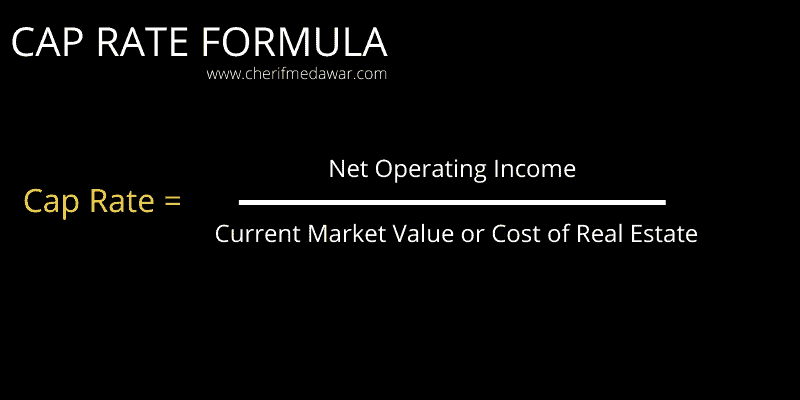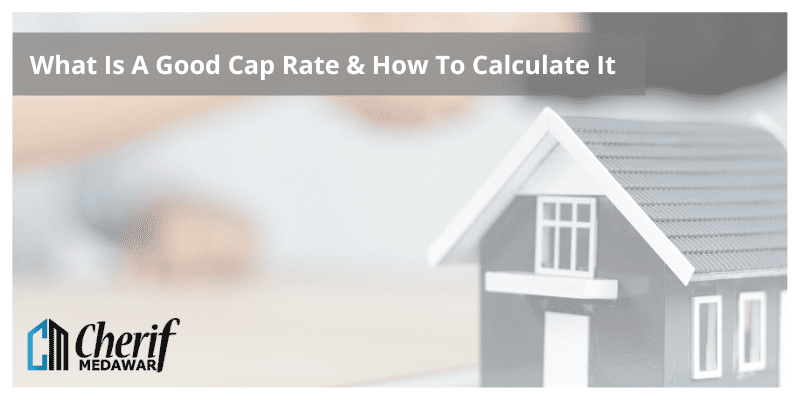Cap rate is a useful metric used to value commercial real estate properties. Often considered a benchmark in the industry, cap rates are more commonly utilized in regards to income producing properties as they are a key indicator of future cash flow.
Finding the cap rate of a property is critical to determining its value. Ideally, you want to make sure the price you pay for a property is less than the combination of rents and capital expenditures when calculated as a percentage of the property’s value. This is where cap rate comes in. Cap rate can be defined in numerous ways including: (1) net operating income divided by cost or market value; (2) gross income divided by cost; or (3) cost divided by net operating income.
What Is Cap Rate?
Cap rate is a real estate term that refers to the ratio of the net operating income (NOI) generated by a particular property to the property’s sales price. Cap rates are used by investors as one indication of how desirable a particular property may be as an investment. There are two parts to a cap rate: capitalization rate and value.
The cap rate is a useful metric for real estate investors looking to evaluate their existing or potential investments, because it gives an indication of how well that property will generate cash flow. It does not take into account other factors like cash-on-cash return and loan payments, but these can be calculated as well to give a complete picture of your investment.
A high cap rate (10%+) indicates that your investment has a low risk of default, while a low cap rate (5% or less) indicates that the property could be at a higher risk of default. Cap rates are commonly quoted as annual figures; however, they can also be calculated on a monthly basis. To convert an annual cap rate to a monthly cap rate, divide by 12. For example, if you have an annual cap rate of 8%, then your monthly cap rate would be 0.67%.
What Is A Good Cap Rate For Rental Property?
A good cap rate for rental property is largely determined by the location of the property and the condition of the market. The return on a real estate investment depends on how much capital you’re willing to invest, what kind of property you’re buying, and how much risk you are prepared to take.
A cap rate is a simple way to estimate the potential return on an investment. It measures the ratio between annual net operating income and purchase price or current market value. A cap rate of 8 percent means that an investor would receive $80,000 in rent annually if they bought a property for $1 million dollars and collected 100 percent of their rent.
It’s important to remember that there are expenses related to owning rental properties — including maintenance costs — so it’s not as simple as dividing the monthly rent by the purchase price. You’ll also need to factor in any maintenance costs and other expenses such as utilities and property taxes.
The formula for the cap rate is:

Cap Rate = Net Operating Income (NOI) / Current Market Value (CMV)
For example, say an investment property has a current market value of $500,000 and is expected to generate $40,000 in net operating income after expenses. Using the above formula we compute:
Cap Rate = 40,000 / 500,000 = 0.08 or 8%
The cap rate formula is as follows:
(Net Operating Income / Purchase Price) x 100 = Cap Rate in percentage form
A cap rate of 10% indicates that the property generates $10,000 per year for every $100,000 in price. Put another way, it would take 10 years for a property to pay for itself if you use only income to finance the purchase.
When Is Cap Rate Used And Why Is Cap Rate So Important?
Cap rate is used when estimating the investment value of a real estate property. This figure tells you how much money you will earn each year on your investment without taking into account interest, taxes, etc., and is calculated by dividing the net operating income of a property by its market value.
The higher the cap rate, the greater the potential return on your investment. Cap rate is one of the most important metrics for real estate investors because it gives an estimate of how much cash flow a property will generate based on its current market price.
When evaluating a property, it’s important to look at the cap rate based on pro forma projections – what you expect the property will return for you once you acquire it, renovate it and fill it up with tenants – as well as the actual returns over time.
In practice, cap rate is often used in place of cash on cash return, which is net operating income (NOI) divided by total cash invested. In addition to the capitalization rate, factors that affect the cash on cash return include:
- Total investment costs
- Loan size and interest rate
- Mortgage amortization period
- Recurring expenses
How To Calculate Cap Rate: Capitalization Rate Formula
The capitalization rate formula is calculated by dividing the net operating income (NOI) by the cost of the asset. So if an apartment building was purchased for $1,000,000 and it generates annual net operating income of $100,000 then the cap rate would be 10%.
When using this formula you are assuming that the NOI will continue indefinitely at the same level and that there will be no further investment in the property after purchase.
Cap Rate = Net Operating Income / Current Market Value or Cost of Real Estate
Cap Rate Vs ROI
A cap rate is an estimate of the potential profit per unit of a property. It’s calculated by dividing total gross income by total cost, and then subtracting all expenses, including vacancies and interest.
ROI, alternatively, is the annual return on investment. While cap rate is used to determine the rental yield, ROI is used to determine the cash flow return. ROI is generally superior because it takes into consideration all expenses and does not vary based on changes in interest rates.
Cap Rate Example
Let’s say you’re considering purchasing a house that is currently rented out to tenants. You are thinking of buying the house for $100,000.
The tenant’s rent is $1,000 per month ($12,000 per year).
The expenses that you expect to incur are $6,000 a year, including maintenance and real estate taxes.
Your net operating income (NOI) would be $6,000.
The capitalization rate would be calculated by dividing NOI by the price you paid: = 6,000 / 100,000 = 0.06 = 6%.
Can Cap Rate Change?
There are a few different ways cap rates can change.
The first is that the property itself may change through physical or functional improvements. For example, if a property is renovated, any new investment would need to be “recaptured” through the Net Operating Income (NOI), which would increase the cap rate.
The second way cap rates can change is when the market changes. If there is a shift in supply and demand, we will also see shifts in cap rates. For example, if seller expectations rise and buyers are willing to pay more for a property, we will see an increase in sale prices, which will cause cap rates to decrease. These shifts in market condition can occur at any time and affect all properties – not just a single asset
Finally, cap rates can change based on investor preferences and risk tolerance. If investors are worried about economic conditions and become more risk-averse, they may require higher returns in order to invest. More conservative investors will want to see higher NOIs and lower cap rates. On the other hand, if investors become less risk-averse during an economic boom, they may be satisfied with lower returns and therefore accept lower NOIs and higher cap rates.
Appreciation And Gentrification
Appreciation is the increase in property values over time. It’s an important factor in both the housing and commercial real estate markets. In areas where appreciation rates are high, buyers can turn a profit by purchasing a home or other property, waiting for it to increase in value (or allowing someone else to live there) and then selling it at the higher price.
The term “gentrification” is used to describe the process of renewal and rebuilding in the wake of urban decay. It’s a process that can be seen in many major cities with older neighborhoods that have experienced a shift in population.
What Is Cash Flow?
Cash flow is just one measure of how well an investment property is performing. It’s also important to consider other metrics such as cap rate, cash-on-cash return, and internal rate of return.
Positive cash flow means that your rental income is more than your property’s expenses and debt payments. Negative cash flow means that your property is costing you money, not making you any.
What Is the Internal Rate Of Return?
The internal rate is the anticipated rate of return if the property is purchased. It is expressed as a percentage that provides an expectation of the future performance of an investment.
The internal rate of return (IRR) helps potential investors measure the returns on a property against other potential investments. It can help them determine if the investment will be worthwhile or not.
IRR is calculated using both positive and negative cash flows over time and takes into account the time value of money. This means that one dollar today is more valuable than $1 tomorrow because that dollar has an opportunity to earn interest over time.
Summary
It is fairly straightforward to determine if a real estate investment has a good cap rate. Some multi-family properties might even have higher cap rates of a few points more than their net operating income (NOI) would indicate. But it is a little trickier to determine if the change in the sales price meets or exceeds the projected amount and whether the property is desirable to prospective buyers.
Learn the Steps to Invest in Commercial Real Estate Like a PRO by becoming a part of Cherif Medawar’s Commercial Real Estate Mastermind

